
01 Aug Our Favorite Picks of Shakuhachi Music
Japanese culture enthusiasts have long been captivated by the ethereal sounds of the Shakuhachi, an ancient bamboo flute that holds deep cultural significance. This article aims to celebrate the rich heritage of Shakuhachi music, showcasing a curated selection of notable pieces that embody the instrument’s versatility and expressive qualities. Join us on a melodic journey through the enchanting world of traditional Japanese music as we present our favorite picks of Shakuhachi compositions.
Overview of the Shakuhachi
The Shakuhachi, with its simple yet elegant design, traces its roots back to ancient Japan. Originally used as a spiritual tool by wandering monks, it evolved into a popular musical instrument. Crafted from bamboo and featuring five finger holes, the Shakuhachi produces hauntingly beautiful tones that evoke a sense of tranquility and contemplation.
Importance of Shakuhachi Music in Japanese Culture
Throughout Japan’s history, Shakuhachi music has played a vital role in various aspects of culture, including religious ceremonies, tea ceremonies, storytelling, and traditional festivals. The meditative and expressive nature of the instrument makes it a powerful medium for communicating emotions, stories, and spiritual themes.
Echigo San-ya: An Ode to Tranquil Nights
“Echigo San-ya,” a classic Shakuhachi composition, dates back to the Edo period. Its origin can be traced to the San-ya district in Echigo (present-day Niigata Prefecture), where it was performed by wandering monks seeking alms. The piece embodies the stillness and peace of the night, taking listeners on a journey through quiet villages and moonlit landscapes.
With its slow and deliberate pacing, “Echigo San-ya” envelops listeners in a serene atmosphere, invoking a sense of introspection and calm. The delicate melodies mirror the night’s natural rhythms, creating a meditative experience that lingers in the heart.
The simplicity of “Echigo San-ya” highlights the Shakuhachi’s ability to convey profound emotions through minimalistic means. The piece demonstrates the instrument’s versatility as it seamlessly captures the essence of a tranquil night and the feelings it evokes.
Hi To Mi: Weaving a Melodic Tale
“Hi To Mi” is an enchanting Shakuhachi piece steeped in Japanese folklore and storytelling traditions. Its title translates to “Scarlet and Green,” symbolizing the vibrant colors of nature and the changing seasons.
As the Shakuhachi weaves intricate melodies, listeners can imagine themselves embarking on a journey through lush forests and blossoming gardens. The song’s narrative quality invites us to immerse ourselves in the poetic tales of nature’s beauty and fleeting moments.
The melodies of “Hi To Mi” soar and dip, evoking a range of emotions from joy and wonder to melancholy and reflection. It is a captivating portrayal of the human experience mirrored in the ever-changing landscapes of Japan.
Ajikan: Meditative Reflections
“Ajikan” holds deep spiritual significance, serving as a meditation aid in Zen Buddhism. Its name derives from the syllables “A,” “Ji,” and “Kan,” representing the beginning, middle, and end—symbolizing the entirety of existence.
As the Shakuhachi emits resonant tones, “Ajikan” invites listeners to embark on an introspective journey, exploring the depths of their consciousness and connecting with the universe.
The composition’s meditative and contemplative character exemplifies the essence of traditional Shakuhachi music—using sound to transcend the physical and delve into the metaphysical.
Haru No Umi: Dancing with Nature’s Rhythms
“Haru No Umi,” or “The Sea in Spring,” embodies the beauty and vitality of the spring season. The piece paints a vivid picture of the sea’s awakening as nature bursts into life.
The song’s lively and rhythmic melodies evoke the sights and sounds of blooming flowers, gentle breezes, and the ocean’s waves dancing harmoniously.
This composition beautifully melds traditional Shakuhachi sounds with modern influences, bridging the gap between the past and the present.
SHIKA NO TONE: Embracing the Wild
“SHIKA NO TONE,” “The Call of the Deer,” pays homage to Japanese folklore’s majestic and mysterious creatures.
Through its melodic complexity, “SHIKA NO TONE” captures the untamed spirit of the wilderness, taking listeners on an enchanting journey through nature’s untamed landscapes.
With its use of extended techniques and dynamic range, “SHIKA NO TONE” showcases the Shakuhachi’s ability to convey a wide array of emotions and themes.
Oshusashi: Bridging Past and Present
“Oshusashi,” a contemporary Shakuhachi piece, embodies the evolution of the instrument’s music and its enduring appeal.
“Oshusashi” harmoniously blends traditional Shakuhachi melodies with contemporary elements, creating a fresh and captivating musical experience.
This piece exemplifies the adaptability of Shakuhachi music, proving that the instrument continues to find resonance and relevance in modern times.
Conclusion
Throughout this musical journey, we have explored the profound cultural significance of Shakuhachi music, celebrating its versatility and dynamic qualities.
As you listen to these enchanting pieces, we invite you to immerse yourselves in the captivating world of Shakuhachi music and delve deeper into the rich heritage of Japanese musical traditions.
The timeless allure of the Shakuhachi endures by captivating hearts and minds, as it has done for centuries, and continues to be a source of inspiration and introspection for Japanese culture enthusiasts worldwide.
Discover the mesmerizing world of Shakuhachi music and be transported by its captivating melodies. If you want to purchase a hand-crafted Shakuhaci flute today, look no further than our website here.


